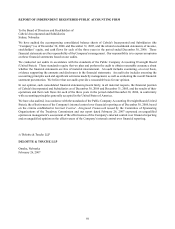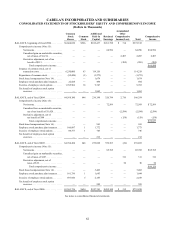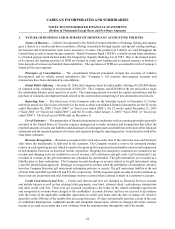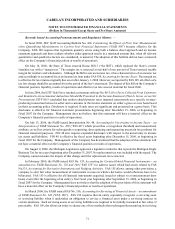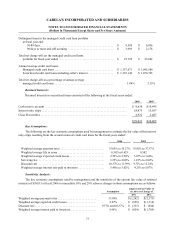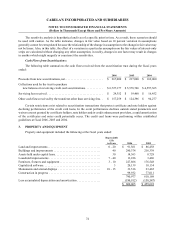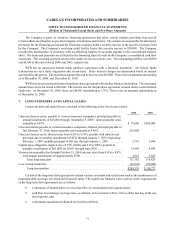Cabela's 2006 Annual Report Download - page 71
Download and view the complete annual report
Please find page 71 of the 2006 Cabela's annual report below. You can navigate through the pages in the report by either clicking on the pages listed below, or by using the keyword search tool below to find specific information within the annual report.
67
CABELA’S INCORPORATED AND SUBSIDIARIES
NOTES TO CONSOLIDATED FINANCIAL STATEMENTS
(Dollars in Thousands Except Share and Per Share Amounts)
held under capital lease agreements are amortized using the straight-line method over the shorter of the estimated
useful lives of the assets or the lease term. Major improvements that extend the useful life of an asset are charged
to the property and equipment accounts. Routine maintenance and repairs are charged against earnings. The cost of
property and equipment retired or sold and the related accumulated depreciation are removed from the accounts and
any related gain or loss is included in earnings. Long-lived assets used by the Company are reviewed for impairment
whenever events or changes in circumstances indicate that the carrying amount of an asset may not be recoverable.
The Company capitalizes interest costs on construction of projects while they are being constructed and before they
are placed into service. For fiscal 2006 and 2005, the Company capitalized interest costs totaling $355 and $371,
respectively.
The Company follows the provisions of American Institute of Certified Public Accountants Statement of
Position (“SOP”) No. 98-1, Accounting for the Cost of Computer Software Developed or Obtained for Internal
Use. In accordance with SOP 98-1, the Company capitalizes all costs related to internally developed or purchased
software and amortizes these costs on a straight-line basis over their estimated useful lives.
Intangible Assets — Intangible assets consist of deferred financing costs, non-compete agreements, purchased
credit card relationships and goodwill and are recorded in other assets. Intangible assets totaled $3,172 and $3,617 at
the end of fiscal 2006 and 2005, respectively, which is net of accumulated amortization of $3,847 and $7,762 for the
respective years. The purchased credit card relationships were fully amortized in fiscal 2005. Intangible assets are
amortized over three to 17 years. Amortization expense for these intangible assets for the next five fiscal years is
estimated to approximate $609 (2007), $326 (2008), $326 (2009), $318 (2010) and $207 (2011).
Land Held for Sale or Development — The Company has a wholly-owned subsidiary whose primary activity
is real estate development. Land that is purchased and held for sale is shown in other assets. Proceeds from sale of
land are recorded in other revenue and the corresponding cost of the land sold is recorded in cost of other revenue.
Marketable Securities — Economic development bonds (“bonds”) issued by state and local municipalities that
management has the positive intent and ability to hold to maturity are classified as held-to-maturity and recorded at
amortized cost. For bonds classified as available-for-sale where quoted market prices are not available, fair values
are estimated using present value or other valuation techniques. The fair value estimates are made at a specific point
in time, based on available market information and judgments about the bonds, such as estimates of timing and
amount of expected future cash flows. Such estimates do not reflect any premium or discount that could result from
offering for sale at one time the Company’s entire holdings of a particular bond, nor do they consider the tax impact
of the realization of unrealized gains or losses.
Declines in the fair value of held-to-maturity and available-for-sale bonds and securities below cost that are
deemed to be other than temporary are reflected in earnings as realized losses. Gains and losses on the sale of
securities are recorded on the trade date and determined using the specific identification method.
Government Economic Assistance — In conjunction with the Company’s expansion into new communities,
the Company often receives economic assistance from the local governmental unit in order to encourage economic
expansion in that local government’s area. This assistance typically comes through the use of proceeds from the sale
of economic development bonds and grants. The bond proceeds and grants are made available to fund the purchase
of land (where not donated), construction of the retail facility and infrastructure improvements. The economic
development bonds issued to fund the project, in certain cases, will be repaid by sales taxes generated from the sales
of that retail destination store, while in other cases the economic development bonds are repaid through property
taxes generated within a designated tax area. The government grants have been recorded as deferred grant income
and have been classified as a reduction to the cost basis of the applicable property and equipment. The deferred grant
income is amortized to earnings, as a reduction of depreciation expense, over the average estimated useful life of
the project.




